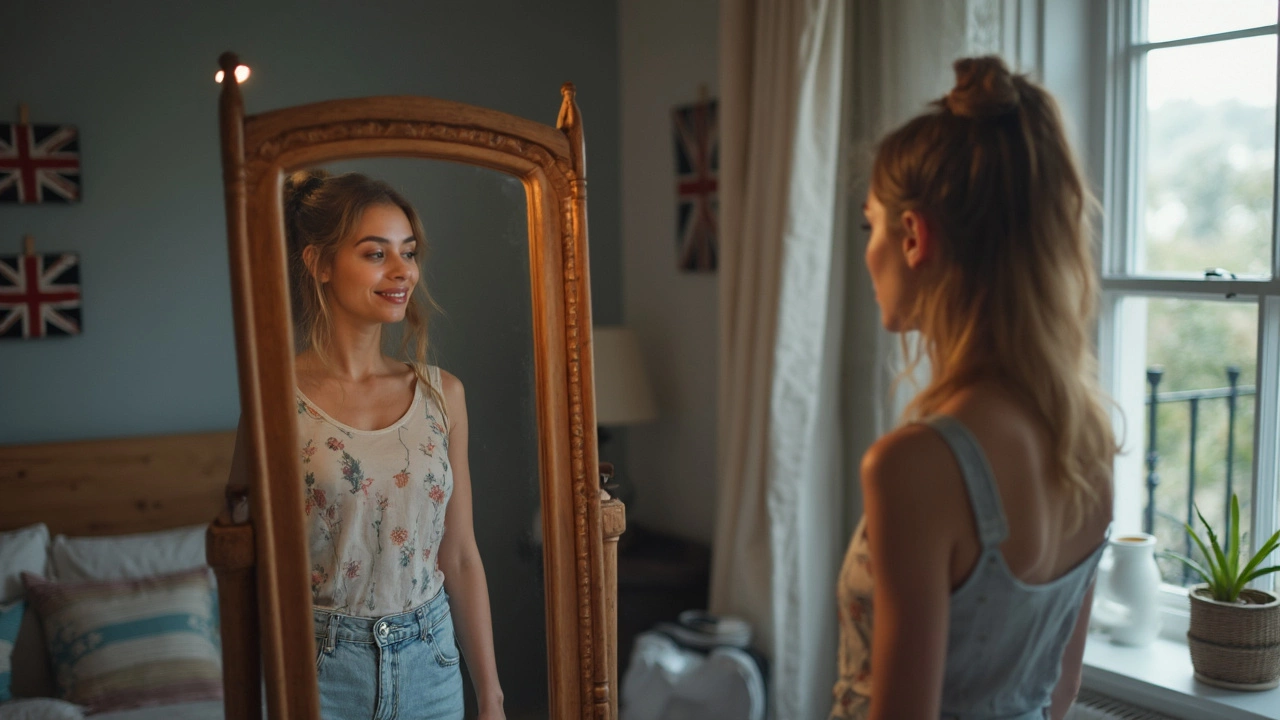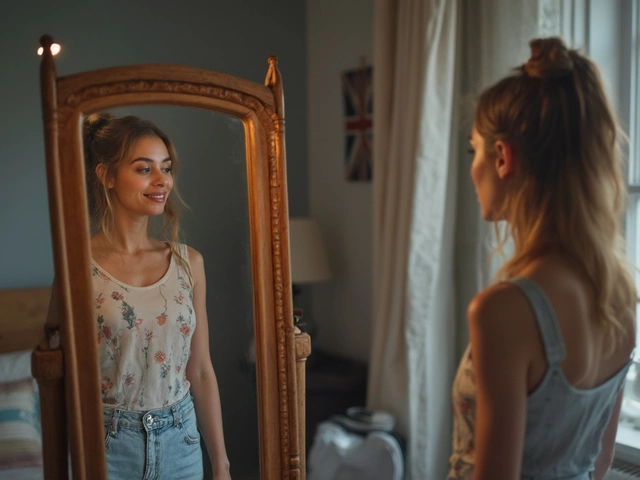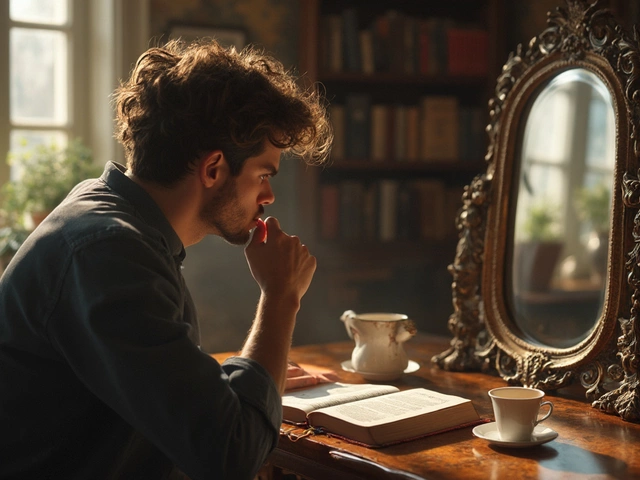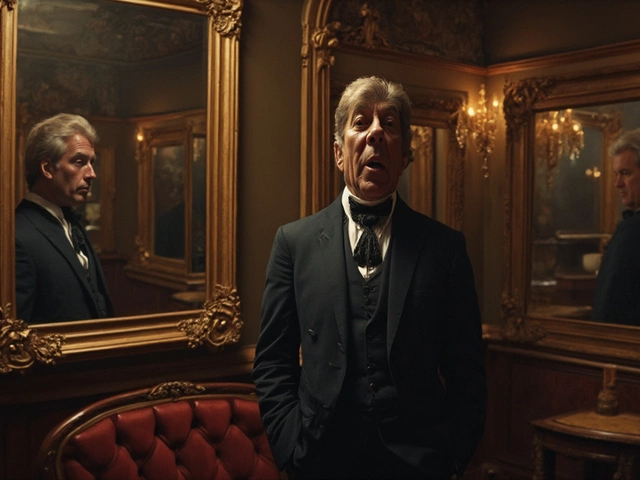Ever squinted at your reflection in a hotel bathroom and thought, 'Yikes, do I really look like that?' Trust me, I’ve been there—once found myself blaming a gas station mirror for a decade of under-eye bags. But the truth isn’t about you changing; it’s about the conditions around you. Not all mirrors work the same way, and there’s a reason you look spectacular in your bedroom but like you missed a week of sleep at the office.
It usually comes down to lighting. Good, soft light makes your skin look smoother and brighter. Harsh or overhead lights? They cast shadows, highlight bumps, and exaggerate wrinkles or under-eye circles. That’s why the ceiling-lit mirror at work can feel so unforgiving, while daylight from the side in your room at home is like an instant Instagram filter. If you want to see your reflection in the most flattering way, start with lighting—stand near a window, or use lamps with warm bulbs at face level, not the ceiling.
- How Light Messes with Your Reflection
- Mirror Quality: It’s Not All the Same
- Shape and Size: The Weird Warping Effect
- Mind Games: Mood and Perception Tricks
How Light Messes with Your Reflection
Light has way more to do with your reflection than most people realize. The type, angle, and even the color of the light around your mirror can totally change how you look, sometimes for the better, sometimes...not so much. Ever noticed how natural daylight tends to be the most forgiving? It spreads evenly and doesn’t throw weird shadows on your face. Compare that to those tiny, super-bright lights you find in store dressing rooms—those things spotlight every little bump or dark circle.
According to the American Lighting Association, "Lighting that hits your face from the sides—rather than above—reduces shadows, making features look softer and more balanced."
"For grooming spaces, vertical lighting close to eye level is the gold standard. It provides even illumination and cuts back on unflattering shadows and highlights." — American Lighting Association
Check out these common light sources and how they change how you look:
| Light Source | Effect on Reflection |
|---|---|
| Daylight (natural, from a window) | Even, shows true colors, gentle shadows |
| Overhead (office, bathroom) | Strong shadows, harsh lines, emphasizes flaws |
| Side lighting (vanity lights) | Soft shadows, minimizes wrinkles, flatters skin |
| Fluorescent (many stores) | Cools skin tone, makes you look pale or washed out |
If you want the most honest—and kind—reflection, stand near a window or use two soft lamps on either side of your mirror. Want to feel a bit better before a big meeting or parent-teacher night? Dim, warm lights at face level can be your best friend. And if you’re ever caught in awful overhead lighting, just remember: hardly anyone looks good in it. It’s the lights, not you.
Mirror Quality: It’s Not All the Same
Here’s something a lot of people don’t realize: not every mirror gives a true reflection. Some are made better than others, and the little details in how a mirror is built can totally change how you look.
Cheap mirrors usually use thinner glass or low-quality backing. This means what you see might bend just a bit or have weird shadows that make your face look uneven or dull. You’ll find these types in big box stores or those $10 full-length mirrors you hung back in your college dorm. Even a tiny warp in the glass can stretch your features or make your body look out of proportion. No, your arms didn’t suddenly get longer overnight—it’s the cheap glass playing tricks.
Better mirrors use thick glass and have a smooth, silver or aluminum coating on the back. High-end or “true” mirrors (like some found in salons) show your face exactly as it is, without warping, and colors stay true. If you’ve ever noticed you look healthier or more evenly colored in one mirror than another, that’s probably it.
Some mirrors add tints—like a faint blue or green—that can mess with the natural look of your skin or hair. Others have poor coatings that fade over time, causing parts of your reflection to look cloudy or patchy. This is common in old bathroom mirrors or ones with dark spots along the edges.
- If you want a flattering, true-to-life look, pick a mirror with thick glass (at least 1/4 inch) and a plain silver backing.
- Check your mirror for warping. Stand back and see if straight objects, like a doorframe, look crooked in the reflection.
- Avoid heavily tinted or old, spotted mirrors for your everyday spot—they really don’t do your face any favors.
It’s not vanity or imagination—it’s science. The right mirror can boost your confidence just by showing what’s really there, not a stretched or shadowed version only a funhouse would love.
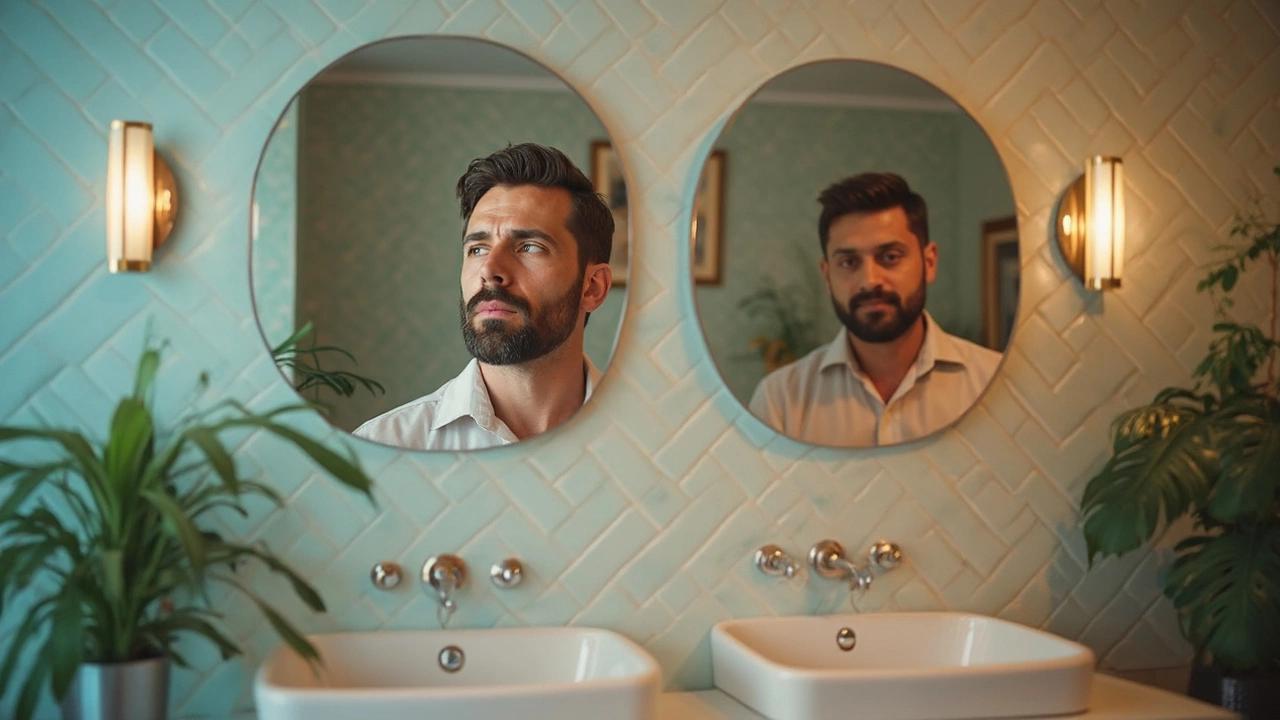
Shape and Size: The Weird Warping Effect
You ever check yourself out in one mirror and you look totally fine, then change mirrors and suddenly your face looks a bit stretched or your waist seems wider? That’s not your imagination. The shape and size of your mirror change the way light bounces, which can seriously mess with your reflection. Think funhouse mirrors at a carnival—just a little bending in the glass and you get those wild wavy looks. But even regular household mirrors can bend a bit or have flaws that create a more subtle version of this effect.
Flat mirrors are supposed to reflect exactly what’s in front of them, but even tiny imperfections cause warping. Big, cheap mirrors usually bend under their own weight, especially if they’re held in place by just a few clips. That can add rolls you don’t have or make your face look a little uneven. Many bathroom mirrors aren’t perfectly flat, and the ones with frames that press on the side often bulge in the middle, making you look wider. Some full-length mirrors even curve a bit, especially when leaned against the wall instead of being properly mounted. That changes the way your whole body looks.
Here’s a quick look at how common mirror types might mess with your reflection:
| Mirror Type | Common Effect |
|---|---|
| Small compact mirror | Usually distorts edges, creates a rounded effect |
| Large wall mirror | May bulge or sag, making you look wider or shorter |
| Leaning floor mirror | Often curves top to bottom, stretches your shape vertically |
| Mounted, framed mirror | Frame pressure may make the center bulge |
If you want the most accurate reflection, grab a mirror that’s completely flat and mounted securely on the wall. Avoid cheap, big-box floor mirrors for checking your outfit, unless you’re cool with looking a little stretched or squished. Even better, try standing in different spots and check if your reflection changes—if it does, the mirror’s shape is probably the culprit. For the best result, use a quality mirror that’s thick and heavy, and make sure it’s actually flat against the wall with solid backing. Your self-esteem will thank you.
Mind Games: Mood and Perception Tricks
Your perception in the mirror isn’t just about glass and light—your brain pulls a lot of strings behind the scenes. Ever noticed how you look better on a good day when you’re feeling confident, and everything just kind of clicks? Scientists call this the "self-enhancement effect." You unconsciously see yourself a little more positively when your mood is up. There’s a Harvard study that found people consistently rated their own face as more attractive than strangers—even when looking at untouched photos of themselves.
Mood swings can go the other way, too. When you’re low, tired, stressed, or anxious, your brain focuses on imperfections. That’s not just you being picky—fMRI scans show that people with low self-esteem activate certain brain areas differently when looking at their own faces compared to confident people.
"Most people do not see themselves objectively. What they see in the mirror is colored by what they feel inside." — Dr. Tara Well, Barnard College psychologist and mirror researcher.
Even the environment matters. If you stand in front of a messy bathroom mirror, you might start focusing on the clutter, making you feel more chaotic or negative, which can color how you see yourself. On the contrary, a clean, well-lit space sets a better tone and can boost your view.
- Try checking your reflection when you're in a neutral or good mood, especially if you have somewhere important to be and don’t need an ego hit.
- Switch up your routine: stand in a different spot, change the time of day you get ready, or even clean your mirror. Sometimes, small mental resets make a big difference.
- Don't compare. The person next to you in the bathroom line is also probably thinking their reflection looks off. Our brains are just weird like that.
Here’s a quick look at how mood and environment affect perception, based on recent research:
| Factor | Change in Self-Perception |
|---|---|
| Positive Mood | Up to 25% more likely to rate appearance as attractive |
| Negative Mood | Focus shifts to flaws; ratings drop by 15-20% |
| Cluttered Environment | Increased stress; higher focus on negatives |
| Well-Lit, Clean Space | Increased satisfaction with own reflection |
So much of what you see staring back at you is more about what’s happening in your head than what’s really there. The next time you catch yourself frowning at your reflection, remember: it’s not always the mirror that’s the problem.
